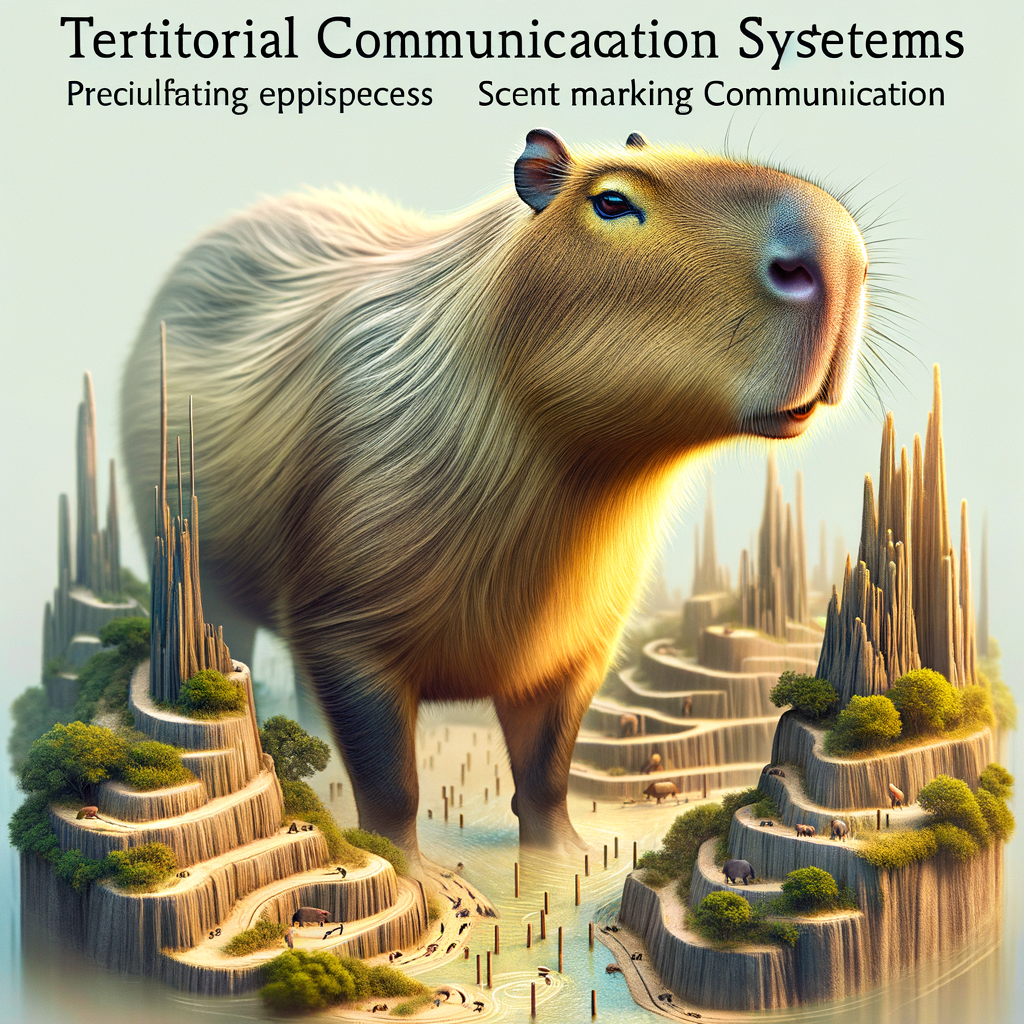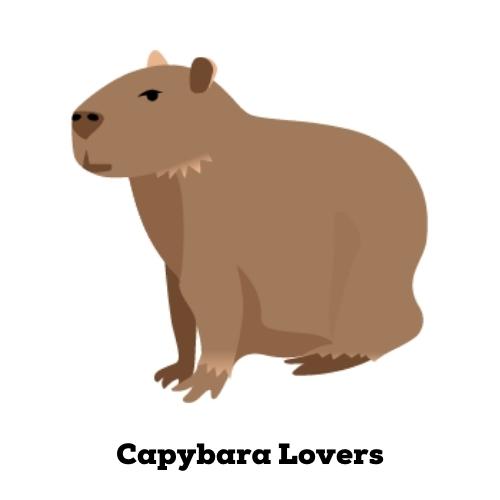
Introduction to Capybara Behavior
Before we delve into the fascinating world of capybara behavior, it’s important to understand who these creatures are. Capybaras are the world’s largest rodents, native to South America. They are highly social animals, known for their unique characteristics, habitat preferences, and territorial behavior. Let’s take a closer look.
-
- Overview of Capybara characteristics
Capybaras are semi-aquatic mammals that can weigh up to 150 pounds and measure up to 4.3 feet in length. They have a barrel-shaped body covered with coarse, brown hair, and webbed feet, which make them excellent swimmers. Capybaras have a calm demeanor and are known to be very social, often seen in groups of 10 to 20 individuals.
-
- Understanding Capybara habitat
Capybaras thrive in areas with abundant water sources. They are found in various habitats across South America, including rainforests, wetlands, and grasslands. They prefer to live near bodies of water such as rivers, lakes, and swamps, which provide them with food, a means of escape from predators, and a place to cool down in the hot climate.
-
- Exploring Capybara territorial behavior
Despite their peaceful nature, capybaras exhibit territorial behavior, especially males. They use scent marking to establish and defend their territory. This behavior is most pronounced during the breeding season when males compete for the attention of females. They also use vocalizations, body postures, and other non-verbal cues to communicate their territorial claims.
In the following sections, we will delve deeper into the scent marking and communication behaviors of capybaras, providing a comprehensive understanding of these intriguing creatures.
Scent Marking in Capybaras
In the fascinating world of animal behavior, scent marking plays a crucial role. This is particularly true for capybaras, the world’s largest rodents. Let’s delve into what scent marking is and why it’s so important.
What is Scent Marking?
Scent marking, also known as territorial marking, is a behavior used by animals to communicate with each other. But what exactly is it, and why is it so important?
- Definition of scent marking: Scent marking is the act of an animal depositing its own scent, usually through urine or other secretions, onto surfaces in its environment. This is a way for the animal to communicate different messages to other animals, often of the same species. For example, it can signal territory boundaries, reproductive status, or even individual identity.
- Importance of scent marking in animals: Scent marking serves a variety of purposes in the animal kingdom. It helps animals establish and maintain territories, attract mates, and communicate their presence to others. It’s a form of communication that is especially important for animals like capybaras, who rely heavily on their sense of smell to understand their environment and interact with each other.
In the next section, we will explore how capybaras use scent marking and what it means for their behavior and communication.
How Capybaras Use Scent Marking
Let’s delve into the fascinating world of capybaras and their unique method of communication – scent marking. This behavior is not only intriguing but also essential for their survival and social interactions.
-
- Methods of scent marking in Capybaras
Capybaras, the world’s largest rodents, have a unique way of leaving their scent mark. They use a special gland located on their noses, known as the “morrillo”. This gland produces a sticky substance that capybaras rub on objects in their environment, leaving a scent mark. This method is often used to establish territory or communicate with other capybaras.
Another method capybaras use is urination. By urinating, they leave a scent trail that other capybaras can detect. This is a common method used by many animals and is a clear sign of marking territory.
-
- Frequency and timing of scent marking
The frequency and timing of scent marking in capybaras can vary based on several factors. These include the capybara’s age, sex, and social status. For instance, dominant males tend to scent mark more frequently than subordinate males or females.
The timing of scent marking also plays a crucial role. Capybaras often scent mark during the early morning or late afternoon. These are the times when they are most active and when other capybaras are likely to encounter their scent marks.
In conclusion, scent marking is a vital part of capybara behavior. It helps them communicate with each other, establish territories, and even find mates. So, the next time you see a capybara rubbing its nose on a tree or urinating, remember – it’s not just a random act, but a form of communication!
Capybara Communication
Communication is a vital part of any animal’s life, and capybaras are no exception. These fascinating creatures have unique ways of interacting with each other, which we will explore in this section.
Understanding Capybara Communication
Understanding the communication methods of capybaras can give us a deeper insight into their behavior and social structure. Let’s delve into the two main forms of communication in capybaras: verbal and non-verbal communication, and scent marking.
-
- Verbal and non-verbal communication in Capybaras
Capybaras use a combination of verbal and non-verbal cues to communicate with each other. Verbal communication includes a variety of sounds such as whistles, purrs, barks, and grunts. Each sound carries a different message, from alerting others to danger to expressing contentment.
Non-verbal communication, on the other hand, involves body language. For example, a capybara may show dominance by standing tall and puffing out its chest. Submissive capybaras, in contrast, may lower their bodies and avoid direct eye contact.
-
- Role of scent marking in Capybara communication
Scent marking is another crucial aspect of capybara communication. Capybaras have scent glands in their skin, which they use to release unique odors. These scents can convey a wide range of information, such as the individual’s identity, reproductive status, and territorial claims.
By rubbing their bodies against objects or other capybaras, they leave behind their scent, effectively communicating their presence and status to others in the group. This form of communication is particularly important in establishing and maintaining social hierarchies within the capybara community.
Understanding capybara communication helps us appreciate these creatures’ complex social dynamics. Whether through sounds, body language, or scent marking, capybaras have developed effective ways to interact and coexist with each other in their natural habitats.
Case Study: Capybara Communication in the Wild
In our quest to understand the communication methods of capybaras, we conducted an in-depth case study. This study focused on observing capybaras in their natural habitat to gain insights into their communication behaviors.
- Observations of Capybara Communication
Our observations revealed that capybaras have a complex communication system. They use a combination of vocal, visual, and scent signals to interact with each other. For instance, we observed capybaras emitting high-pitched whistles and purrs to alert their group members about potential dangers. They also use body postures and facial expressions to communicate their intentions and emotions.
One of the most fascinating aspects of capybara communication is their use of scent marking. Capybaras have specialized glands that produce a unique scent, which they use to mark their territory and communicate their social status. This form of communication is particularly important during mating season, as it helps capybaras identify potential mates.
- Key Takeaways from the Case Study
Our case study provided several key insights into capybara communication. Firstly, capybaras have a rich and complex communication system that involves a combination of vocal, visual, and scent signals. This communication system plays a crucial role in their social interactions and survival in the wild.
Secondly, scent marking is a vital aspect of capybara communication. It serves multiple purposes, including territory marking, social status signaling, and mate selection. This finding underscores the importance of scent communication in the animal kingdom, particularly among social animals like capybaras.
Lastly, our study highlighted the need for further research into capybara communication. Understanding the communication methods of animals like capybaras can provide valuable insights into animal behavior and ecology, and can contribute to their conservation efforts.
In conclusion, our case study has shed light on the fascinating world of capybara communication. It has shown us that even in the animal kingdom, communication is a complex and multifaceted process that is vital for survival and social cohesion.
Territorial Marking in Animals
In the world of animals, territory is everything. It’s a place to find food, a safe space to rest, and a location to raise offspring. One way animals communicate their claim to a territory is through something called territorial marking. Let’s delve into this fascinating behavior.
Overview of Territorial Marking
Before we dive into specific examples, let’s first understand what we mean by ‘territorial marking’.
-
- Definition of territorial marking: Territorial marking is a behavior used by animals to claim a specific area or territory. They do this by leaving behind a mark, often a scent, that other animals of the same species can recognize. This mark serves as a message to other animals, telling them that this territory is already claimed.
-
- Examples of territorial marking in different species:
Many different types of animals use territorial marking. Here are a few examples:
-
- Lions: Male lions mark their territory by spraying urine on trees and bushes. This strong scent warns other lions to stay away.
- Wolves: Wolves use their urine and feces to mark their territory. They also use scratching and rubbing against trees to leave their scent.
- Beavers: Beavers use a sticky substance called castoreum to mark their territory. They produce this substance in a gland near their tail and spread it around their territory.
- Birds: Many birds use song to mark their territory. The song serves as a warning to other birds of the same species to stay away.
As you can see, territorial marking is a common behavior in the animal kingdom. It’s a fascinating way that animals communicate with each other and maintain their personal space. In the next section, we’ll compare how capybaras, a large rodent species from South America, mark their territory compared to other species.
Comparing Capybara Territorial Marking to Other Species
Let’s delve into the fascinating world of animal territorial marking by comparing the methods used by capybaras with those of other species. We will also explore how their habitat influences this behavior.
-
- Similarities and Differences in Territorial Marking Methods
Like many other animals, capybaras use scent marking to establish their territory. They do this by rubbing their scent glands against objects in their environment. This is similar to how cats, dogs, and many other mammals mark their territory.
However, there are also some differences. For instance, while wolves and dogs use urine to mark their territory, capybaras use a unique method. They have specialized glands located on their noses, called “morrillo”, which they rub on objects to leave their scent. This is a unique feature among rodents, making capybara territorial marking distinct from other species.
| Species | Marking Method |
|---|---|
| Capybara | Morrillo gland rubbing |
| Wolf | Urine marking |
| Cat | Scent gland rubbing |
-
- Impact of Habitat on Territorial Marking
The habitat of an animal greatly influences its territorial marking behavior. For capybaras, who are semi-aquatic and live in groups, their marking behavior is quite unique. They often choose objects near water bodies for marking, as these are the areas they frequent the most.
In contrast, a solitary animal like a tiger marks its territory by scratching trees and spraying urine, focusing on the boundaries of its territory to keep other tigers away. The habitat, in this case, dense forests, influences this behavior.
Thus, the habitat plays a significant role in the territorial marking methods of different species, including capybaras.
Animal Scent Communication
Animals have a unique way of communicating with each other that is often invisible to humans. They use scent, a powerful tool in the animal kingdom, to send messages to their peers. Let’s delve deeper into understanding this fascinating form of communication.
Understanding Animal Scent Communication
Animal scent communication, also known as olfactory communication, is a complex and vital aspect of animal behavior. It plays a significant role in various activities such as hunting, mating, and marking territory. Let’s explore the role of scent in animal communication and some examples from different species.
-
- Role of scent in animal communication
Animals use scent to communicate a wide range of messages. For instance, they can indicate their readiness to mate, their dominance, or even their presence in a particular area. Scent can also be used to warn others of potential danger. This form of communication is especially prevalent in nocturnal animals who rely heavily on their sense of smell due to limited visibility.
-
- Examples of scent communication in different species
Various species employ scent communication in unique ways. For example, dogs use their keen sense of smell to identify each other and understand the world around them. They can detect pheromones, which are chemical signals, to gather information about other dogs.
Another example is the African elephant, which uses scent to detect water sources and potential mates from miles away. Similarly, ants leave a scent trail for other ants to follow when they find a food source.
In conclusion, scent communication is a crucial part of animal behavior, allowing them to interact with their environment and each other in sophisticated ways. From dogs to elephants to ants, each species utilizes this form of communication uniquely, showcasing the incredible diversity of the animal kingdom.
Case Study: Scent Communication in Capybaras
Let’s delve into a fascinating case study that explores the intriguing world of scent communication in capybaras, the world’s largest rodents.
-
- Observations of scent communication in Capybaras
Capybaras, native to South America, are known for their unique scent communication methods. They possess specialized glands, known as ‘morrillo,’ located on their noses. These glands produce a distinctive scent that capybaras use for various forms of communication.
During the observation period, it was noted that capybaras often rub their morrillos against objects in their environment. This behavior, known as scent marking, serves multiple purposes. It helps capybaras establish territory, signal their reproductive status, and communicate with other members of their group.
Interestingly, the frequency and intensity of scent marking were observed to increase during the breeding season, suggesting a significant role in mating rituals. Male capybaras were seen to scent mark more frequently than females, indicating a possible link to dominance and competition for mates.
-
- Key takeaways from the case study
The case study provided valuable insights into the complex world of capybara communication. Here are the key takeaways:
| Key Takeaway | Explanation |
|---|---|
| Scent marking is crucial for capybara communication | The study confirmed that scent marking plays a vital role in capybara communication, serving functions such as territory establishment and mating signals. |
| Scent marking frequency varies | The frequency of scent marking was observed to increase during the breeding season and was more common in males, suggesting a role in dominance and competition. |
| Scent communication is complex | The study highlighted the complexity of scent communication in capybaras, indicating that it involves more than just marking territory or signaling reproductive status. |
In conclusion, this case study has shed light on the intricate and fascinating world of scent communication in capybaras. It underscores the importance of further research into animal communication methods, which can provide us with a deeper understanding of animal behavior and ecology.
Conclusion: Decoding the Scent Language of Capybaras
Our exploration into the fascinating world of capybaras has led us to some intriguing discoveries. Let’s summarize our findings and discuss the implications for understanding wildlife communication methods.
-
- Summary of findings on Capybara communication and territory marking
Capybaras, the world’s largest rodents, have a unique way of communicating and marking their territories. They use scent marking as a primary form of communication. This is done through a special gland located near their noses, which they rub on various objects to leave their scent. This scent language is not just about marking territory, but also conveys important information about the individual capybara’s age, sex, and reproductive status.
-
- Implications for understanding wildlife communication methods
Understanding the scent language of capybaras gives us valuable insights into the communication methods of wildlife. It shows us that animals have complex and nuanced ways of interacting with each other, often beyond our human senses. This knowledge can help us better protect and conserve wildlife, by respecting their communication methods and territories.
Decoding the scent language of capybaras has been a journey of discovery. We’ve learned that these creatures have a complex system of communication that goes far beyond simple territory marking. This understanding opens up a new perspective on how we view and interact with wildlife.
As we continue to explore and understand the natural world, let’s remember to respect and protect these fascinating creatures and their unique ways of communicating. After all, every creature has a story to tell, and every scent, a message to convey.













